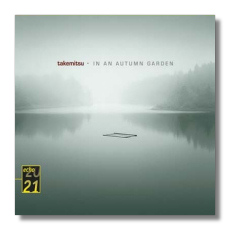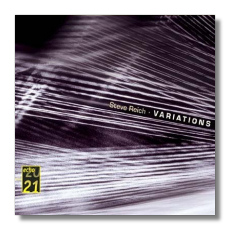
The Internet's Premier Classical Music Source
Related Links
-
Reich Reviews
Takemitsu Reviews - Latest Reviews
- More Reviews
-
By Composer
-
Collections
DVD & Blu-ray
Books
Concert Reviews
Articles/Interviews
Software
Audio
Search Amazon
Recommended Links
Site News
 CD Review
CD Review
20/21 – Echoes of Our Time

Tōru Takemitsu
- In an Autumn Garden
- Voyage
- Autumn (excerpt)
- November Steps: 10th Step (Variation)
- Eclipse
Kinshi Tsuruta, biwa
Katsuya Yokoyama, shakuhachi
Music Department, Imperial Household
Deutsche Grammophon 471590-2 ADD 71:22


Steve Reich
- Variations for Winds, Strings, and Keyboards
- Music for Mallet Instruments, Voices, and Organ
- Six Pianos
Steve Reich and Musicians
San Francisco Symphony Orchestra/Edo de Waart
Deutsche Grammophon 471591-2 ADD/DDD 64:42
As a complement to Deutsche Grammophon's "20/21 – Music of Our Time" series, DG has started to release some older recordings under the "20/21 – Echoes of Our Time" heading. These two discs are among the first releases. Others are devoted to Ligeti and Gubaidulina, and five more titles are slated for reissue in the near future.
Eastern traditions and Western innovations inform the work of Japanese composer Tōru Takemitsu (1930-1996). One of his inspirations, for example, was the work of Claude Debussy, and another was Japanese traditional music. Lately, a good many Takemitsu CDs have become available, but many of them chronicle his work in Western idioms and with Western instruments. The present CD is a splash of cold water in the face of all that: not a Western instrument is to be heard on this disc, and nary a Western gesture. In an Autumn Garden (1973) was written for a Japanese gagaku orchestra. Voyage (also from 1973) is scored for three biwas (the biwa is a lute-like instrument), and the remaining works are scored for biwa and shakuhachi, a type of flute. (Note that we are given only an excerpt of Autumn (1973), and the tenth variation of November Steps (1967) – essentially an extended cadenza for biwa and shakuhachi.)
Listeners without a grounding in Japanese musical traditions – and I, sorry to say, am one – will not be entirely able to appreciate what Takemitsu has done with these traditions. It's like wandering around a busy Japanese town without an interpreter. Still, this is an unusual listening experience, as the some of the sounds are unlike anything in Western music. The shakuhachi has an intensity, even a wildness, that is quite foreign to the Western flute. The biwa has unusual percussive characteristics; accelerating repetitions of a single tone are, I gather, characteristic of traditional biwa style. They can be heard here, and I can imagine many listeners being surprised to learn that they are hearing a stringed instrument.
These recordings were made in Tokyo in 1974-75. The clear analog recording allows one to appreciate the silences between the sounds as well as the sounds themselves. Fascinating stuff, yet somewhat inscrutable.
Steve Reich's CD includes two works from his early maturity (Music for Mallet Instruments, Voices, and Organ and Six Pianos both date from 1973) and his first foray into orchestral writing, Variations for Winds, Strings, and Keyboards, which dates from 1979. These are arranged in reverse chronological order on the CD, and also in decreasing order of "prettiness." It has been argued that Reich's music loses some of its artistic rigor when it is played by an orchestra, and that it becomes less substantial. In fact, the word "gauzy" has been applied to the Variations. I don't disagree, but while the results are "Reich Lite," if you will, his Minimalism probably seems palatable to a broader audience when there is a greater variety of timbres, is there is here. The music is quietly but unceasingly active in tone and emotionally positive, and it falls easily on the ears. Reich has compared the work's three sections to three variations on a chaconne bass, but I doubt most listeners will hear Variations as such, because the timeframe of the "theme" actually is very slow, although the tracery around it remains quick and agile throughout. This recording was made in 1983, and was an early digital release – LP and CD – on the Philips label.
Reich and his ensemble recorded the other two works for DG in 1974. (This is when it was terribly chic of the label to be involved with such music.) Both pieces are constructed upon the same plan: take a repeating musical pattern, then, note by note, duplicate the pattern, but duplicate it out of phase with the first pattern. In Music for Mallet Instruments, Voices, and Organ, Reich then develops the piece by overlaying augmentations of the musical pattern – lengthening of the note values to create a subjective slowing-down. In Six Pianos, Reich continues the music's development by doubling the music's patterns and by, in effect, fading the doublings in and out to emphasize different parts of the musical pattern at different times. The former work is rather seductive, thanks in part to the coos of the three female vocalists (who include new music standard-bearer Joan LaBarbara) and also because of the exotic tones of the marimbas, glockenspiels, and metallophone. The latter is drier and more machine-like; the pianos are treated as percussive instruments in Six Pianos. Think of this as anthill music; I like it because it helps me to feel productive!
Copyright © 2002, Raymond Tuttle


















